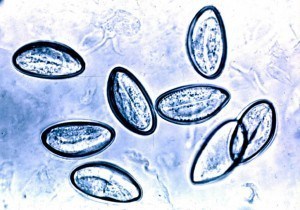Enterobius vermicularis also known as pinworm or threadworm or seatworm is a white roundworm parasite that has worldwide distribution. It affects persons of all ages and socioeconomic statuses. School-aged and pre-school-aged children are most commonly affected.
Adult female worm migrates out of the anus, usually at night, and deposits her eggs on the perianal area, the eggs are not commonly found in feces though they may occasionally be found on the surface of stool specimens or on underclothing, pajamas, or sheets about 2 to 3 hours after falling asleep. The stool is not an appropriate specimen for the diagnosis of pinworm.
Itching during the night in a child’s perianal area strongly suggests pinworm infection. Diagnosis is made by identifying the worm or its eggs.
As the eggs are mostly deposited on the perianal area scotch tape preparation is used to isolate and identify the eggs of pinworm when suspected of pinworm infections. To increase the chance of finding pinworm eggs, the scotch tape preparation method should be done on three consecutive mornings.
Table of Contents
Principle
The clear-cellulose tape preparation is the most widely used procedure for the detection of human pinworm infections. Adult Enterobius vermicularis worms inhabit the large intestine and rectum; however, the eggs are not normally found in fecal material. During the period of extraintestinal migration, the adult female migrates out of the anal opening and deposits the eggs on the perianal skin, usually during the night.
The eggs, and occasionally the adult female worms stick to the glued (sticky) surface of the cellulose tape. These cellulose tape preparations are submitted to the laboratory, where they are examined under a microscope. Commercial collection systems ‘pinworm paddles’ are also available.

Time of specimen collection
The specimen is collected from the perianal skin. An early-morning sample, before the patient has bathed, or used the toilet, is optimal. Up to six successive day morning samples should be collected before a negative result is issued.
Procedure
- Take a piece of clear (not frosted) cellophane tape (use clear, transparent tape ONLY. Cloudy, “magic” tape must not be used.) approximately 4 inches (10 cm) long.
- Hold the tape between thumbs and forefingers with a sticky side facing upward.
- While the child is still asleep during the morning, press the sticky side of the tape against the skin across the anal opening with even, thorough pressure. The eggs stick to the tape.
- Gently place the sticky side of the tape down against the surface of a clear glass slide.
- Label the slide in pencil with the patient’s name, medical record number, and the date and send it to the parasitology laboratory.
- Examine the slide under a microscope using the low power (10x) objective. The eggs can be made more visible by detaching the tape from the slide, adding a drop of xylene or toluene, and again affixing the tape.
Results
The eggs of E.vermicularis measure 50-60 micrometer x 20-30 micrometer and have a relatively thick, smooth shell and an ovoid shape flattened on one side, much like a flattened, partially inflated football. It may contain a partially or fully developed larva.
Adult worms occasionally are seen in transparency tape preparations. They measure 1 cm long, and have a pointed tail posteriorly and transparent wings flanking the anterior end.
Reporting results:
A. Report the organism and stage. Do not use abbreviations.
Example: Enterobius vermicularis eggs present.
B. Report adult worms.
Example: Enterobius vermicularis adult worm present.
C. Report negatives.
Example: No Enterobius vermicularis eggs or adults seen.
Precautions
- The eggs of E. vermicularis are infectious if swallowed, so the person obtaining the specimen must wear the gloves.
- If an opaque tape is submitted by mistake, a drop of immersion oil on the top of the tape will clear it enough to proceed with the microscope examination.
Limitations
- The female pinworm deposits eggs on the perianal skin only sporadically.
- Without multiple tapes (taken on a consecutive morning), it is not possible to determine if the patient is positive, or negative for the infection
References
- Cho, S. Y., & Kang, S. Y. (1975). Significance Of Scotch-tape Anal Swab Technique In Diagnosis Of Enterobius Vermicularis Infection. Kisaengch’unghak chapchi. The Korean journal of parasitology, 13(2), 102–114. https://doi.org/10.3347/kjp.1975.13.2.102
- Rawla P, Sharma S. Enterobius Vermicularis. [Updated 2023 Aug 1]. In: StatPearls [Internet]. Treasure Island (FL): StatPearls Publishing; 2023 Jan-. Available from: https://www.ncbi.nlm.nih.gov/books/NBK536974/

